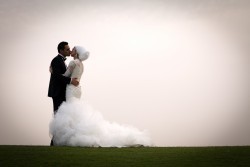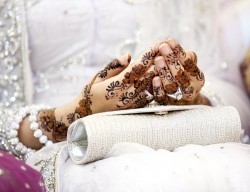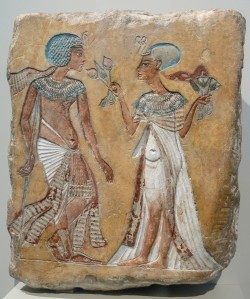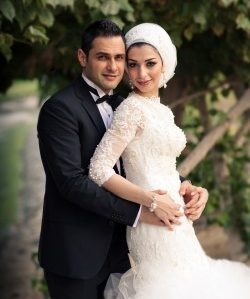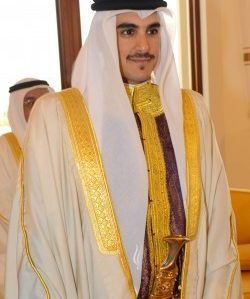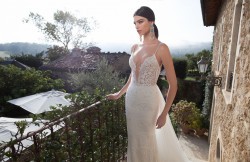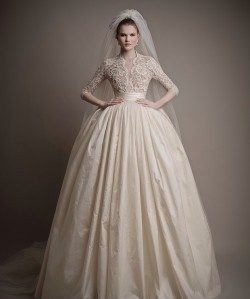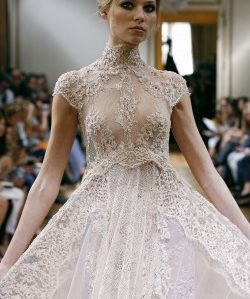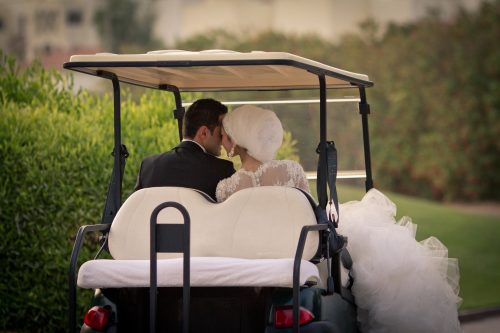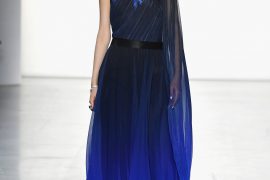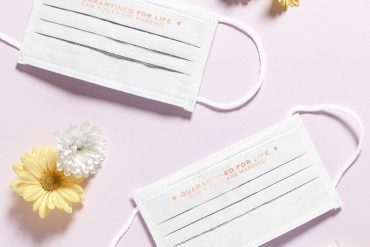Weddings in the Middle East vary from state to state and from one religion to another; although predominantly Muslim, Orthodox or Coptic Christianity and Judaism are also practiced. The tradition of wearing wedding rings also originated in this region and at the wedding each guest is given five almonds that symbolize the five sacred wedding wishes of health, happiness, wealth, fertility and longevity. It is common for a Middle Eastern wedding to feature five different parties including the engagement party, the party to celebrate the signing of the wedding contract, the Henna Party, Reception and Bridal Shower. Some will celebrate a full week of dinners and entertainment prior to the actual Nuptials and some will celebrate after the Nuptials for “Seven” Days. With all of this celebration the bride to be and her guests will have several fashion decisions to make which can be exciting and daunting at the same time!
Middle Eastern women have become the world’s biggest buyers of high fashion and bridal haute couture. This might be surprising to some considering the tradition that many Arab women are kept covered. Most women from prominent families have a very active social calendar with approximately 15-20 weddings a year as well as numerous private parties every month which excludes the presence of men; therefore they are free to dress as they please. Most cultures in this region have their own unique traditions. The following are wonderful examples:
Egypt
The very first relationships to be legally and religiously bound were those in ancient Egyptian society. Not many couples realize that today’s vows of marriage are an age old Egyptian tradition, and they is ancient symbolism in each part of the ceremony. One important symbol is the perfect circle of a wedding ring which dates back to ancient Egyptian in 3,000 BC, where the rings represented a union “without beginning, without end.”
Egypt has diverse religious beliefs, various customs and ceremonies for marriage which are dictated by the couple’s shared religion; which may be Islamic, Muslim, Christian or Coptic Christian, so be advised in the Egyptian culture be cognizant of the fact that your ceremonial events, costumes and traditions will be greatly influenced by the relevant religious faith.
The marriage contract is signed and registered by a “maazon”, an official who has the license to sign and register the marriage contract, in attendance of the couple and their families and friends, which happens in the bride’s house, church or mosque.
Jordan
For Bedouin Weddings, the bride is dressed in an embroidered wedding dress in gold or silver jewelry often with a green silk cloth covering her head. The female relatives process her to the groom’s tent where the wedding takes place. After seven days of marriage, the female relatives of the groom wash and dress the new bride, who is now officially a married woman of the groom’s household. For Non-Bedouins, Many brides opt for Western-style white dresses; grooms a formal black suit. Traditional wedding celebrations last a week that begins with small gatherings of family and close friends. As the days pass and the wedding grows closer, the parties increase in size. The night before the wedding, the bride’s hands and feet are painted with henna by the women in her family as they sing and dance and tell stories.
Lebanon
A Lebanese wedding tradition called “zaffe” starts with friends, family, and in some cases with performers and dancers as they escort the groom to his bride in a shower of shouted blessings and flower petals. The Lebanese wedding enjoys in their celebration, dancing and joyous clapping.
Wedding engagements in Lebanon are usually organized in the bride’s home. The groom brings lots of presents. Lebanese weddings can last for up to three consecutive days. The most impressive is the day of Zaffeh. Nowadays this term means wedding celebration in general. The wedding starts with two parties – one in groom’s home and one in bride’s home. With the arrival of groom to bride’s home the third party starts.
There is a lot of food and dancing. Classical Lebanese belly dancing is often performed at the wedding reception. It symbolizes transformation of the bride into a sensual woman. The couple serves ghoraibi cookies to the guests, the white butter cookies symbolizes the bride’s purity. The party lasts till dawn.
When the bride and groom are leaving the bride’s home women gathered there give them blessings. The “Ah Weeeee-ha” and the “zalghouta” are the joyous sounds that can be heard at every wedding, a sign of joy with thrown petals and rice on the bride and groom.
If the bride steps on a single girl’s foot it is believed that it will bring her luck and that she is going to marry soon.
Dubai
Wedding attire for the men of Dubai include a white full-length shirt-dress, called khandura or dishdasha. This goes with gutra, a white or red-checkered headdress. Women, on the other hand, wear a long black robe to cover their normal clothing. This robe is called abaya. They likewise wear a headscarf while in public. Wedding traditions in Dubai involve a great deal of preparations on the part of the bride. A typical preparation:
• Only the members of the bride’s family and her other relatives are allowed to see her for 40 days, beginning on the confirmation of the wedding date until the day of the wedding.
• As the wedding day nears, extracts of jasmine and amber are used to wash her hair; her whole body is lavished with fragrant perfumes and traditional oils.
• On Laylat Al Henna (literally, night of the henna),
her hands and feet are decorated with henna. This night is very special for her because it’s a “ladies’ night only.”
Iraq
The “nishan” is the wedding celebration for Iraqi couples. During the nishan, the groom and the groom’s family traditionally shower the bride with gifts of jewelry, diamonds and specifically gold. At one time brides used to wear up to seven dresses for this celebration but today it is more common for 3- 5 gowns depending on the couple’s financial status.
In the past, arranged marriages were common. However, this practice is becoming rare. Recently, a law was passed that gave authority to a state-appointed judge to overrule the wishes of the father in the event of an early marriage. The Muslim majority traditionally views marriage as a contract between two families, as the family’s needs are considered most important. In urban settings, women and men have more options in choosing their spouses, though the proposed spouse still must have parental approval. Partners often come from the same ethnic group, and though marriage between different ethnic groups is accepted, it is not too common. The ruling Baath regime considers marriage to be a national duty that should be guided and encouraged. Starting in 1982, women were forbidden to marry non-Iraqi men. If they were already married, they were prohibited from transferring money or property to their spouses.
Israel
Our first thought of an Orthodox Jewish wedding is one of modesty and classic elegance where the bride wears a gown that covers from her collarbone and shoulders but while this notion is still true for many conservative families, the concept of a wedding gown has made a dramatic shift for non-orthodox Israeli brides.
Wedding dresses out of Israel have become increasingly sexier and it seems Israel’s wedding dress designers are leading the way even in the western world with daring bridal collections that takes sexy to a whole new level.
For Jewish families, the wedding is considered a personal Yom Kippur, a day of repentance and forgiveness of the couple. The Jewish practice of wearing white is for spiritual pureness. The Orthodox bride will wear white to symbolize that she has been to the mikvah in preparation for the wedding.
Marriage is a holy institution in Judaism. It’s very name in Hebrew, “kiddushin,” means “sanctification.” Most of the laws and customs relating to the wedding ceremony (Chatunah), its preparations and Seudat Mitzvah (festive reception meal) date back thousands of years.
Jewish law enjoins the entire community to bring joy and happiness to both the Kallah (bride) and Chatan (groom).
At the conclusion of the ceremony, the Rabbi will ask the best man to place a wine glass, wrapped in a white cloth or special bag the couple provides, under the bridegroom’s right foot. The bridegroom will break it, symbolizing: the destruction of the temple in Jerusalem, man’s short life on earth; that even in the midst of the happy occasion we should not forget how fragile life truly is. After the glass is broken, the guests shout “Mazel Tov,” clap their hands, embrace and sing as the couple departs. The bride and bridegroom will kiss immediately after being declared “man and wife” and then run up the aisle into a Yichud which is a brief seclusion where the couple can spend a few moments together before joining their guests. When the couple has fasted until the ceremony, this is their opportunity to break the fast with either a chicken soup or their favorite food. Even couples who have not fasted appreciate the few moments alone in what is usually a hectic and emotionally packed day.
So which ever customary ceremony you’re inspired to follow, make it count and do it all in love.

